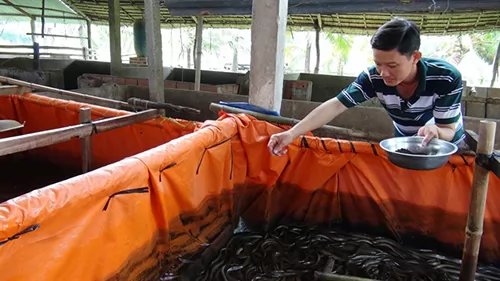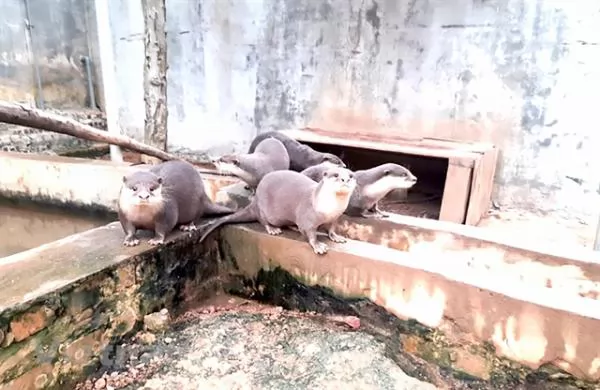Đồng Tháp to release floodwater into rice fields

Farmers in the Mekong Delta’s province of Đồng Tháp take advantage of the flooding season to breed fish, shrimp and other aquatic species and grow other aquatic crops. — VNA/VNS Photo Chương Đài
Viet Nam News | HCM CITY — The Cửu Long (Mekong) Delta province of Đồng Tháp plans to release flood water into more than 81,000 hectares of rice fields between August and October to enrich the soil with sediment.
The release of water will not affect the production of other fields.
Farmers and local authorities will give suggestions about the time and quantity of flood water that should be released, according to the province’s Department of Agriculture and Rural Development.
The delta’s annual floods are caused by the rising water levels of the Mekong Delta in the rainy season.
Nguyễn Thanh Hùng, vice chairman of the provincial People’s Committee, said last year the province released flood water into more than 113,600 ha of rice fields.
The flooding helps destroy germs, reduces the cost of improving the fertility of the fields and helps crops grow.
Đồng Tháp authorities have also carried out measures to protect summer-autumn rice and other crops from waterlogging.
In Hồng Ngự District, one of the hardest-hit flooding areas in Đồng Tháp, local authorities and farmers have strengthened rice protection dykes and set up teams to monitor dykes and sluices.
The district has set up 28 rescue teams to protect agricultural production and people in case of emergency.
Floodwaters have caused damage to dozens of hectares of vegetables and crops in alluvial grounds in Hồng Ngự District.
Lê Thị Loan in the district’s Long Khánh A Commune said her 2,000sq.m of cabbage fields were inundated by floodwaters.
She estimated a loss of about VNĐ8 million (US$350) in her investment into this field.
Flood benefits
The annual floods enrich fields with sediment, support fisheries and aquatic ecosystems, and offer a livelihood for many farmers.
Farmers take advantage of the flooding season to breed fish, shrimp and other aquatic species and grow other aquatic crops like lotus and water lily.
Locals also catch fish and other aquatic species during the flooding season and harvest other wild crops.
Common sesban, water lily, linh fish and other aquatic species are specialities of the delta’s flood season.
Nguyễn Văn Đực Em, who harvests common sesban in the flooding season in Hồng Ngự District’s Thường Phước 2 Commune, said his family gets up at 2am to pick common sesban for selling and now earns an income of VNĐ500,000 -700,000 ($22 - 30) a day from harvesting the flower.
Common sesban is sold for VNĐ60,000 – 70,000 ($2.6 - 3) a kilo.
Bùi Thị Sương has been harvesting fish and other aquatic species in Hồng Ngự District’s Thường Thới Hậu A Commune in the "rising water" season for more than 10 years.
“Every year I look forward to the flooding season,” she said.
Hồng Ngự and Tân Hồng districts, as well as Hồng Ngự Town, are the province’s upstream areas where floods occur first.
As floods arrived early this year and the water level is higher, fishermen are preparing tools to catch fish.
Phan Văn Triều, who catches shrimp in Hồng Ngự District’s Thường Thới Hậu B Commune, is making several dozen new shrimp traps, which he considers to be better than store-bought traps.
Producers that produce tools for catching fish and other aquatic species in Đồng Tháp said the demand for tools is about two times higher than in non-flooding areas. Fishing nets are the most popular item.
Ngô Phúc Lộc, who makes fishing tools in Lai Vung District’s Long Hậu Commune, said his establishment produces more than 100 fishing nets a day at a cost of VNĐ120,000 – 200,000 ($5 – 8.8) each.
In Hồng Ngự Town’s Bình Thạnh Commune, 100 households who make bamboo crab traps are selling to locals and exporting to Cambodia.
Trương Thanh Hưng, who has made bamboo crab traps in Bình Thạnh for 10 years, said he makes more than 1,000 traps every year during flooding season.
The traps sell for VNĐ28,000 – 30,000 ($1.2 – 1.3) each and producers can earn a profit of VNĐ10,000 – 15,000 from each trap, he said.
“The sale of bamboo crab traps is high from now to September,” he said. — VNS
Maybe you are interested

Super–intensive farming of white-legged shrimp brings high profits
TRÀ VINH – Super-intensive white-legged shrimp farming areas have expanded threefold over last year after bringing in high incomes for farmers in the Cửu Long (Mekong) Delta province of Trà Vinh.

Wildlife conservation maintains biodiversity
Wildlife conservation aims to promote comprehensive development of society, maintain biodiversity and preserve precious resources for humanity. Lê Minh Tuyên, director of the Forest Protection Sub-department, spoke to Hà Nội Mới (Hà Nội New)

Exporters said to ignore Mekong products
HCM City – Farmers and producers in the Mekong Delta say they have a number of specialities that can be exported, but authorities have not paid enough attention to them.





